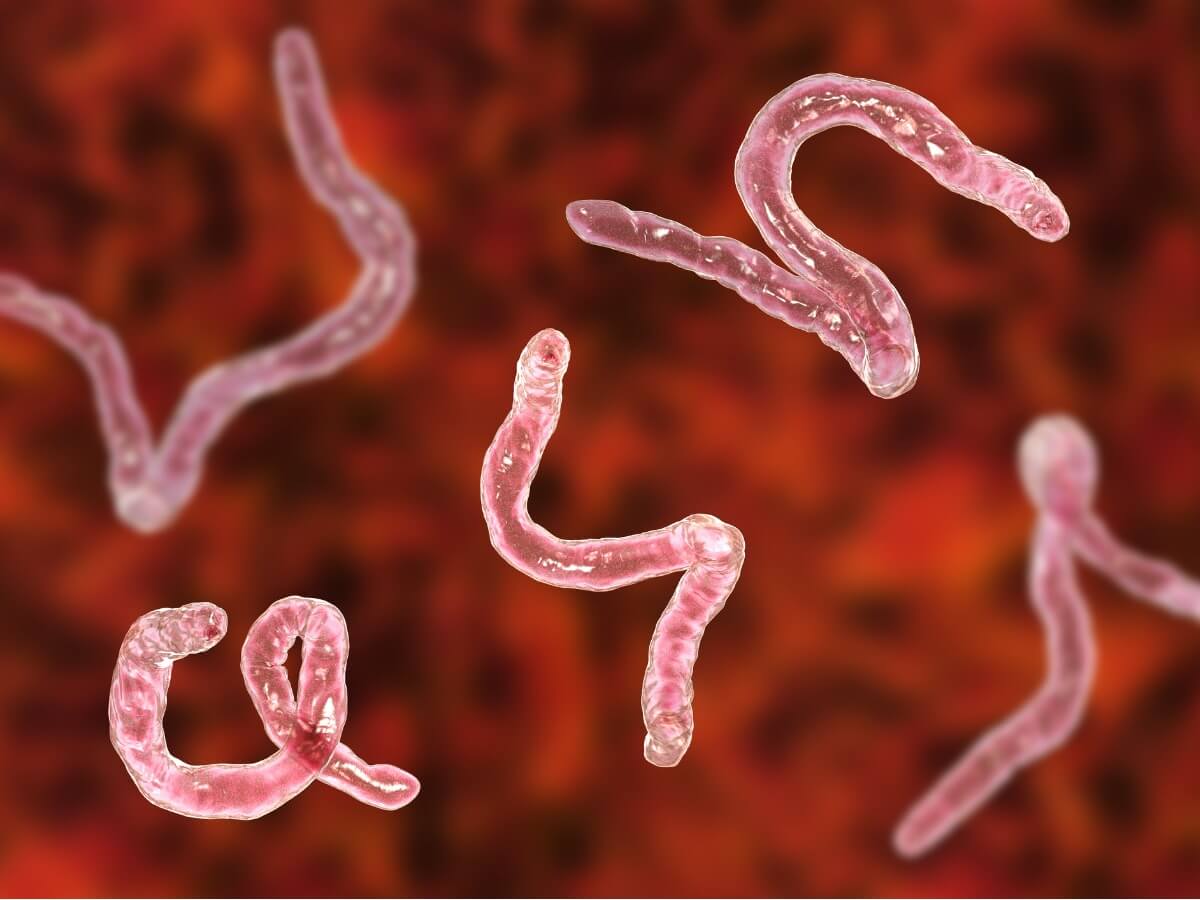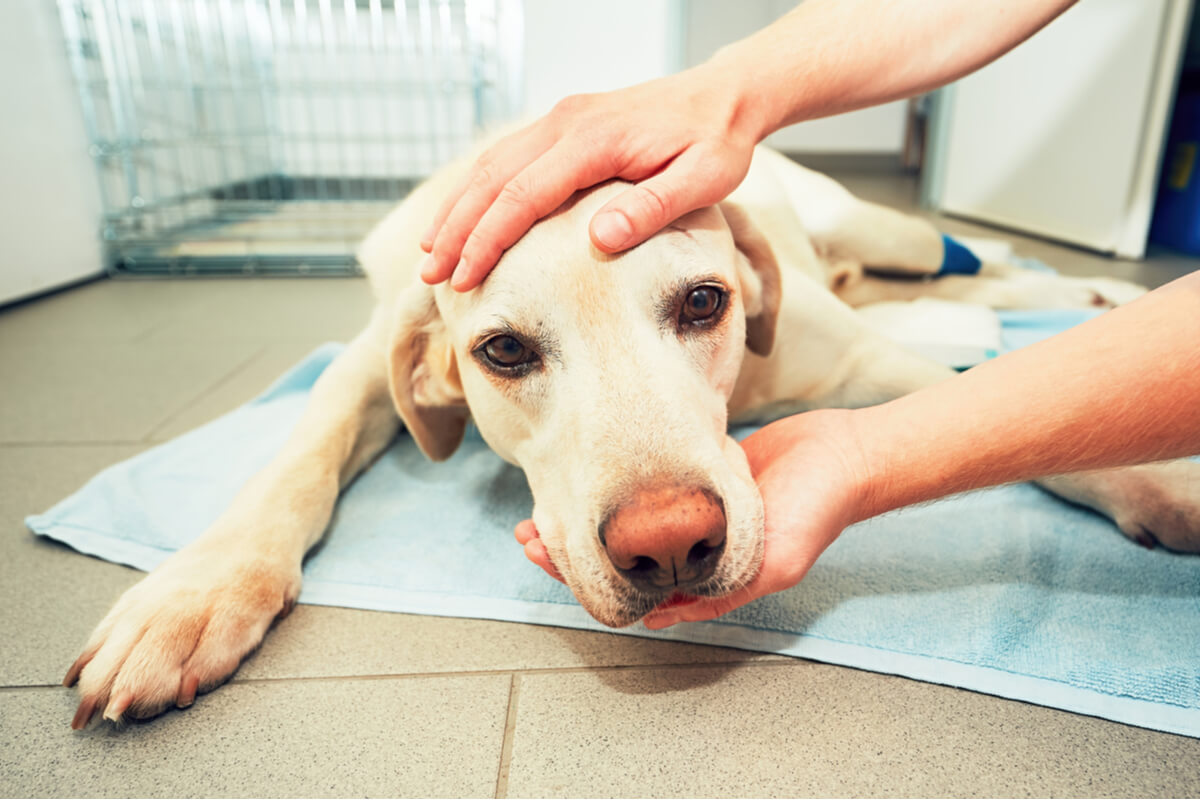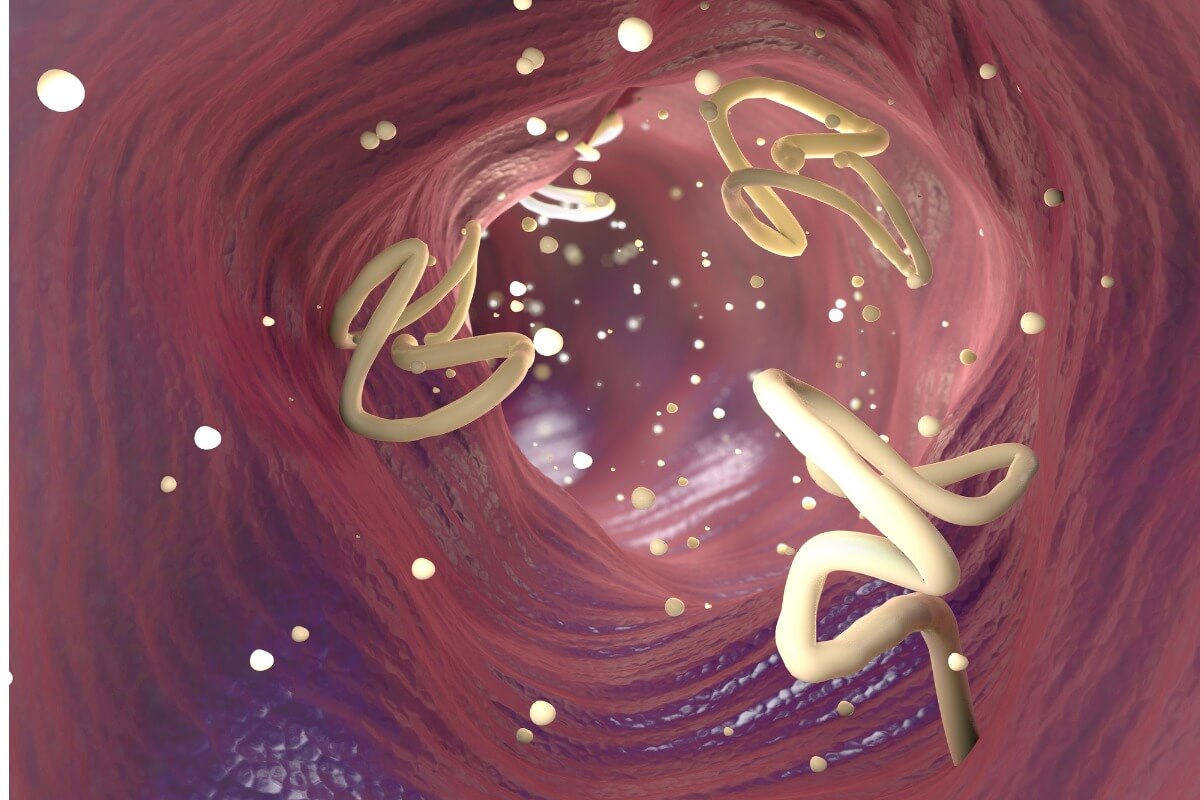Hookworms in Dogs: Symptoms and Treatment


Written and verified by the biologist Cesar Paul Gonzalez Gonzalez
Hookworms are endoparasites that feed on their host, with the sole purpose of reproducing and spreading the disease. These organisms have the ability to anchor themselves to the wall of the intestines of their host, where they feed and reproduce easily. Due to their life cycle, they can cause various symptoms, which, in some cases, are lethal for dogs.
The importance of this nematode is that it’s capable of infecting canids, entering through the skin. Contrary to other types of parasites, hookworms don’t need to enter their host through the mouth to start the infection, they’re even capable of migrating through various organs before reaching the intestine. If you want to know more about this worm and how to avoid it, read on.
Hookworms in dogs
These types of parasites are capable of infecting a wide variety of carnivorous animals. Hookworms are part of the group of helminths, so their morphology is similar to that of an earthworm. It’s small, and barely reaches 13 millimeters in length. However, it has a great reproductive capacity and an adult female produces up to 20,000 eggs a day.
Infection with these helminths can occur in dogs of any age. However, its lethality is higher in the smallest canids and in those that don’t receive adequate medical attention.
Clinically, this disease is known as canine hookworm. It’s characterized by frequent diarrhea with traces of blood, as hookworms tear the wall of the dog’s intestine, in order to feed on the circulating blood. The pathogenetic mechanism is somewhat similar to what some blood-sucking leeches do, but inside the body.
When we talk about hookworms, we’re actually referring to a wide variety of species, which are included in the genus Ancylostoma at a taxonomic level. In dogs, the most common species are the following:
- Ancylostoma caninum, the most common
- A. braziliense
- A. ceylanicum
- A. stenocephala

The life cycle of hookworms in dogs
This nematode spends part of its life in free form and the other part as an adult parasite inside the dog. Taking into account that parasites focus their lives on getting a host and then reproducing, we’ll focus on what happens right after reproduction. In this sense, the eggs that are produced come out through the feces, reaching the ground and thus beginning their cycle.
Free life phase
Once the egg is on the ground, it takes approximately 24 hours for it to hatch and the first larva (stage L1) to emerge. As with other invertebrates, to continue growing, it needs to eat and shed its skin, so it feeds on the organic matter available in the soil. With each exoskeleton molt, the larvae reach a new stage in their life cycle.
The larva goes through all its phases in a maximum of 22 days, depending on the temperature and the availability of food. These nematodes prefer warm environments, and grow faster in these climates. The last free-living larva is stage 3 (L3), which reaches the end of its second molt. When it reaches this point, it’s able to infect its host – in this case the dog.
Parasitic life phase
To begin the invasion, this parasite needs to enter the dog’s body. To do this, it has 2 main routes: through the mouth or through the skin. The quickest and easiest way to infect canines is orally, as the pathogen simply follows the digestive system all the way to the intestine and anchors there.
However, this genus of nematodes has a “trump card”, as it can pierce the skin to enter its host. This means that simply walking in an area that’s infested by L3 larvae of this nematode is more than enough to become infected.
If the parasite enters the skin, it follows a lymphatic route, which allows it to easily reach the heart. From this organ, it passes directly to the lungs, and from there, it moves to the region of the mouth (trachea-pharynx). In this place, the mouth will swallow it and it continues its route to the intestine. This process takes between 2 and 7 days, and so the first symptoms of the infection aren’t very noticeable.
Finally, the larva anchors itself to the intestine by means of hooks in its mouth. Here, it begins to feed on the dog’s blood. Finally, when it gets all the food it needs, it molts one last time to reach sexual maturity. In this way, it’s able to mate and reproduce, producing the eggs that will start the cycle again.
The causes of hookworms in dogs
As mentioned, this parasite has two main entry routes, however, they aren’t the only ones. In dogs, there are clinical cases that have shown that pregnant mothers can also transmit hookworm. Because of this, there are four main routes of infection in dogs:
- Cutaneous (skin): Thin skin contact with nematode larvae.
- Oral (mouth): The larvae of the parasite are ingested directly.
- Placental: Pregnant mothers can infect their puppies through the fetus’ placenta.
- Breastfeeding: If the mother becomes infected during the lactation period, she can infect the puppies through her milk.
Depending on the route of infection, the larvae may remain inactive, which could mean a delay in symptoms.
Symptoms of hookworms in dogs
The symptoms of hookworm infection in dogs are diverse. Symptom severity increases or decreases depending on the number of hookworms infecting the host. The first signs of infection are usually related to the skin. We’ll tell you some:
- Dermatitis: Skin irritation due to the entry of the parasite.
- Acanthosis: Reaction of the immune system that causes thickening of the skin.
- Lacerations: Small wounds along the body of the dog.
- Swelling: Similar to what happens with a mosquito bite. It consists of a superficial inflammation, caused by the entry of the nematode.
- Deformation of the claws: The parasite can cause deformation of the claws when entering through the area of the feet.
It must be taken into account that these symptoms are only caused when the larva enters through the skin. If the infection occurred through the oral route, the symptoms will be directly those of an advanced infection.
Larva in the intestine
Once the larva has already reached the intestine area, we can find a little more aggressive cases. In this phase, some of the symptoms are the following:
- Dark diarrhea
- Weight loss
- Anemia
- Rough or dry hair
- Pale mucous membranes
- Weakness or low activity
- Enteritis: Inflammation of the intestine, presence of stools with or without blood

This medical condition comes from the loss of blood, caused by the action of hookworms in the dog’s intestine. That’s why infections in puppies can be lethal. It’s estimated that each hookworm can suck up to 0.1 milliliters of blood per day. Because there are usually several hundred of them, it can lead to severe anemia and be fatal.
As for adult dogs, this condition won’t be so obvious and often goes unnoticed. However, it isn’t advisable to overlook slight changes in the dog’s behavior, as the condition can be complicated by secondary infections of the disease.
How to diagnose hookworm in dogs
Hookworm in dogs can only be diagnosed by a veterinary professional, as it’s necessary to perform a stool analysis, which helps you check if the eggs of this nematode are present in the feces. This procedure is the best test to check if the dog is parasitized by hookworms or some other invertebrate.
The vet is even likely to ask for complementary blood tests. They do this with the sole objective of verifying the patient’s health status, as it can help them see the severity of the anemia. In addition, the blood count makes it easier to rule out any other condition or infection.
Treatment
The first step is to correct the nutritional deficit that the patient has. This implies directly treating the anemia and the dehydration that this pathology causes. Depending on the case, it may be necessary to administer supplements or even perform blood transfusions. Only the veterinarian is qualified to recommend the best available treatment.
Once the patient has stabilized, treatment with anthelmintic drugs continues, with the aim of completely eliminating the hookworms from the dog’s intestine. In addition to this treatment, the use of antibiotics may be necessary to combat possible bacterial infections.
Anthelmintics can be prescribed in single doses or in multiple doses. This will depend entirely on the severity of the case and the hookworm infection. In addition, dogs that have already had hookworm build resistance, so they don’t usually need aggressive treatment in successive exposures to the pathogen.
Hookworm prevention
The best recommendation is that you deworm your pet regularly. Dewormers contain drugs that fight a wide range of parasites. In this way, you maintain the health of your canid and avoid several visits to the vet.
Also, remember to pay special attention to the puppies and their mother. Deworm your pet when the vet tells you to. If you observe strange or unusual behavior, go to a professional: he’s the only one trained to give your pet the attention they need.
My dog has hookworms, can I get it?
Yes, it is possible to catch this infection from your dog. This pathology belongs to a group of diseases called zoonotic. This means that it’s capable of being transmitted between humans and animals, so you have to be very careful.
As in dogs, the larvae of this nematode can enter orally and cutaneously. In humans, they cause almost the same symptoms as in dogs: anemia, weakness of the body, diarrhea, etc. In addition, this helminth can cause something known as larva migrans, which refers to the passage of the nematode through the skin.

For both dogs and humans, the best defense against hookworm is always prevention. It’s best to deworm yourself and your family if the dog in the house has this condition, to avoid problems in the future. Go to the doctor or the vet when necessary: take care of yourself and take care of them.
All cited sources were thoroughly reviewed by our team to ensure their quality, reliability, currency, and validity. The bibliography of this article was considered reliable and of academic or scientific accuracy.
- Bowman, D. D., Montgomery, S. P., Zajac, A. M., Eberhard, M. L., & Kazacos, K. R. (2010). Hookworms of dogs and cats as agents of cutaneous larva migrans. Trends in parasitology, 26(4), 162-167.
- Kalkofen, U. P. (1987). Hookworms of dogs and cats. Veterinary Clinics of North America: Small Animal Practice, 17(6), 1341-1354.
- Gómez, A. P., Proy, H., Eljure, N., Dieguez, C. A., Rocher, C. C., & Bonifaz, A. (2013). Larva migrans cutánea relacionada con Ancylostomas. Dermatología Revista Mexicana, 57(6), 454-460.
- Alfaro, M. (2011). Prevalencia de Ancylostoma caninum en Canis lupus familiaris en el área urbana y periurbana de la colonia Zacamil, del municipio de mejicanos, san salvador. Universidad de El Salvador, 1-63.
- Yoshida, Y., Okamoto, K., & Chiu, J. K. (1968). Ancylostoma ceylanicum infection in dogs, cats, and man in Taiwan. The American journal of tropical medicine and hygiene, 17(3), 378-381.
This text is provided for informational purposes only and does not replace consultation with a professional. If in doubt, consult your specialist.